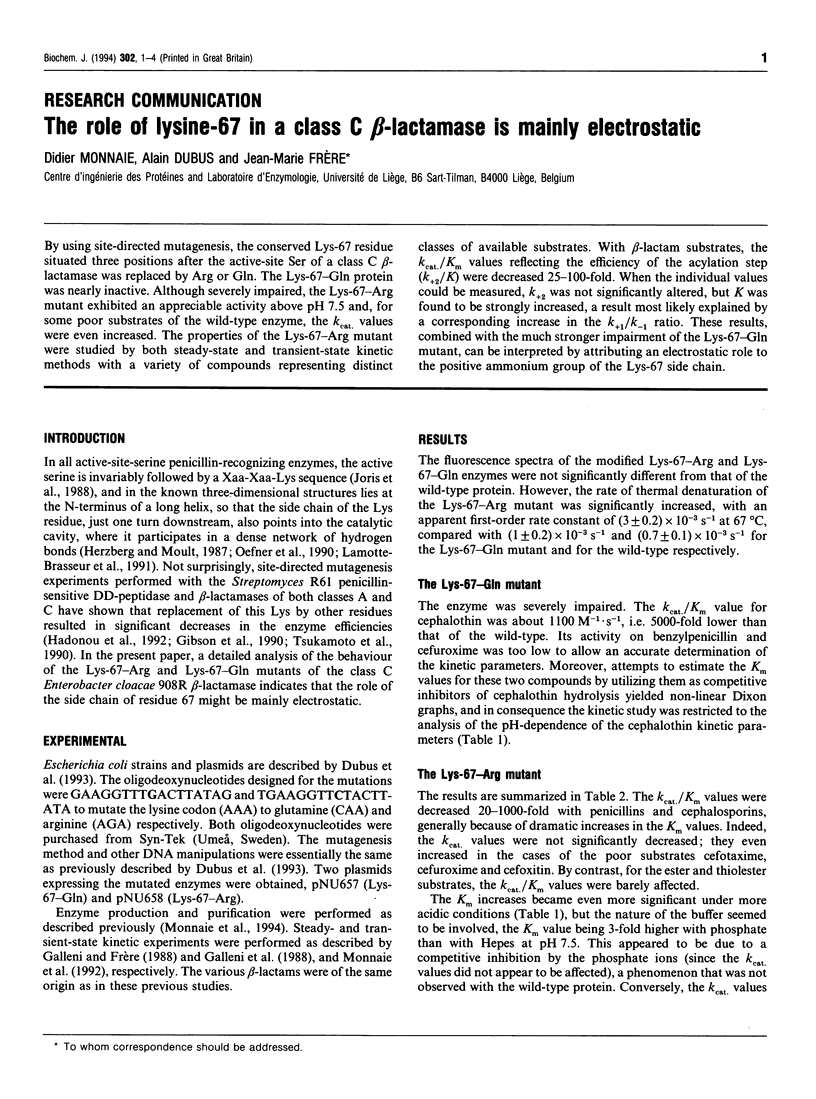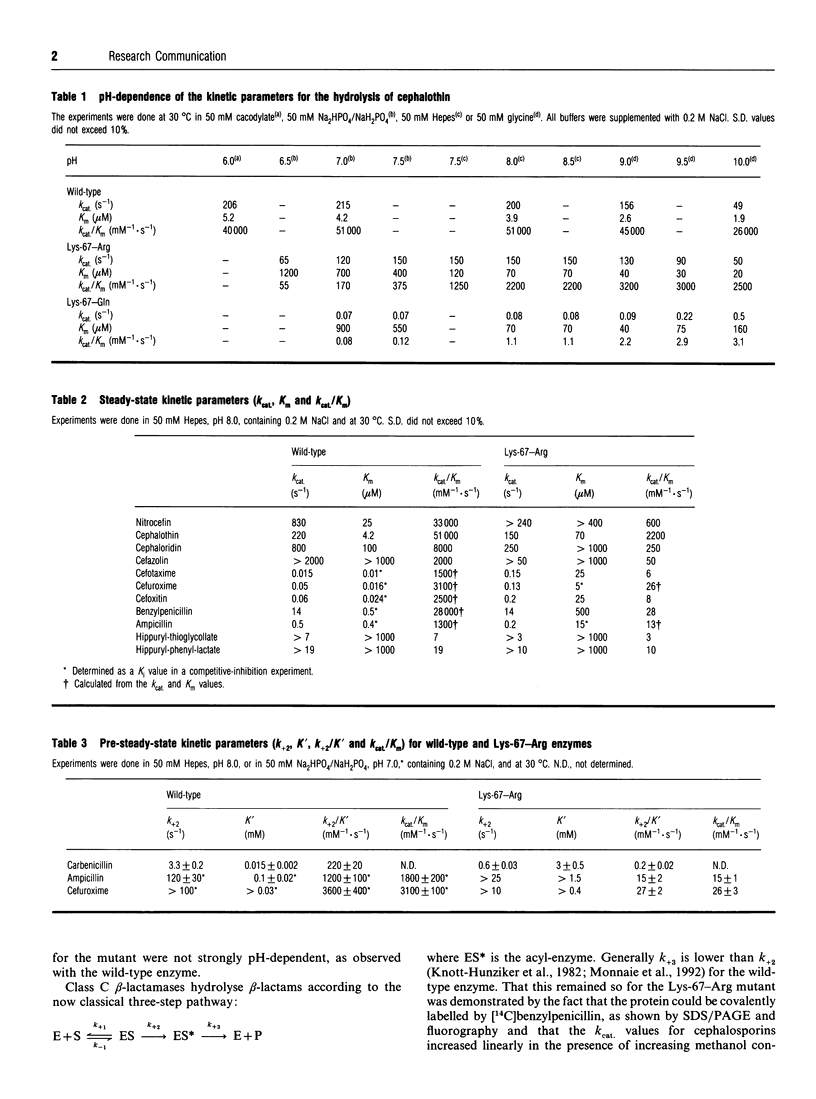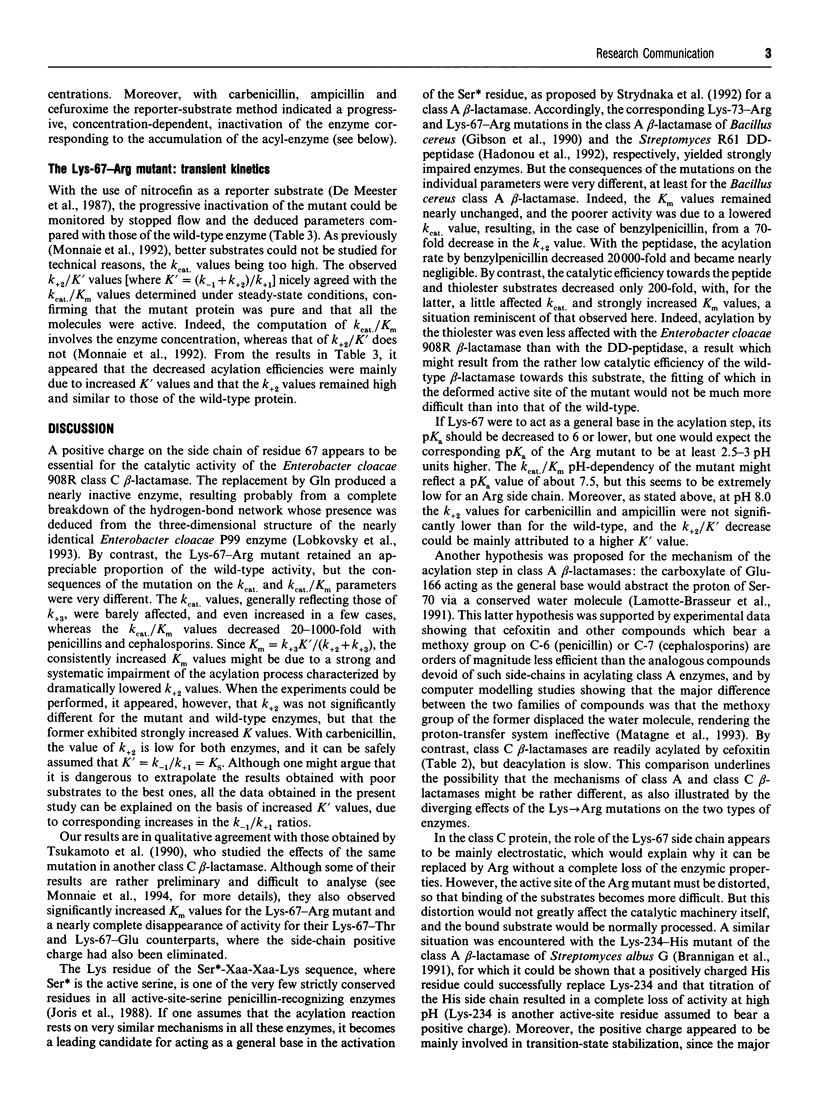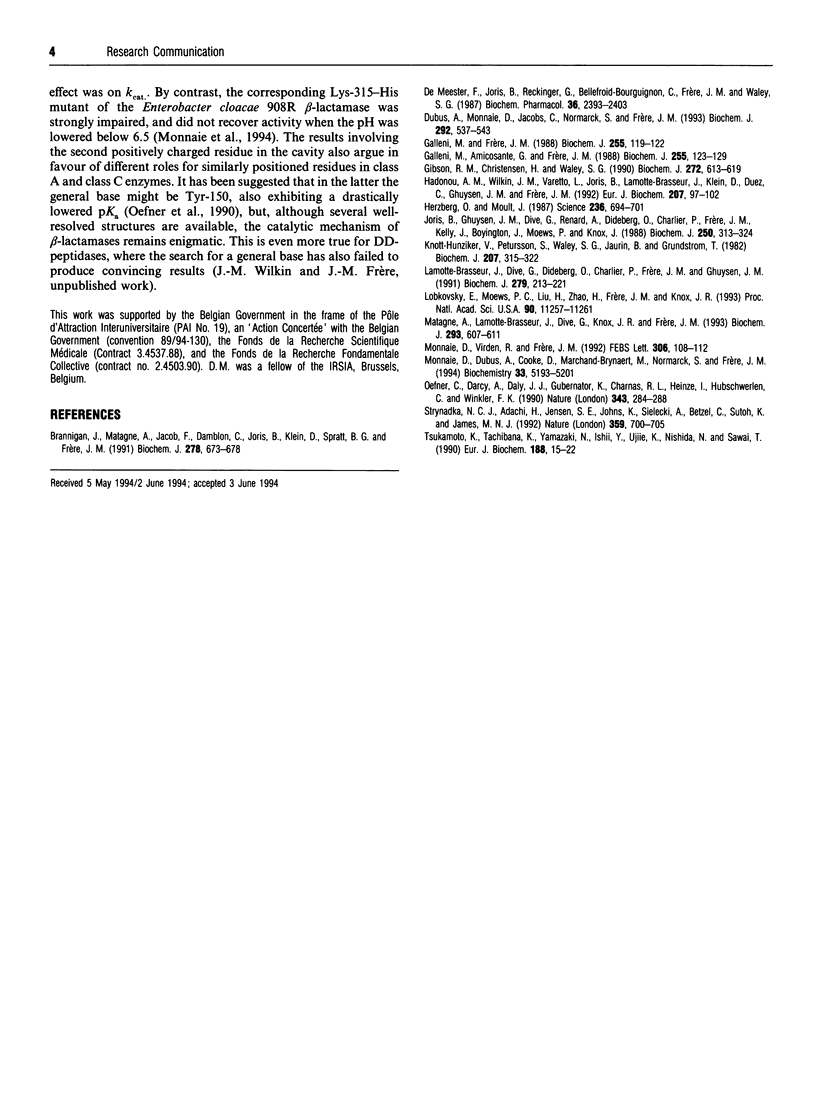Abstract
By using site-directed mutagenesis, the conserved Lys-67 residue situated three positions after the active-site Ser of a class C beta-lactamase was replaced by Arg or Gln. The Lys-67-Gln protein was nearly inactive. Although severely impaired, the Lys-67-Arg mutant exhibited an appreciable activity above pH 7.5 and, for some poor substrates of the wild-type enzyme, the kcat. values were even increased. The properties of the Lys-67-Arg mutant were studied by both steady-state and transient-state kinetic methods with a variety of compounds representing distinct classes of available substrates. With beta-lactam substrates, the kcat./Km values reflecting the efficiency of the acylation step (k+2/K) were decreased 25-100-fold. When the individual values could be measured, k+2 was not significantly altered, but K was found to be strongly increased, a result most likely explained by a corresponding increase in the k+1/k-1 ratio. These results, combined with the much stronger impairment of the Lys-67-Gln mutant, can be interpreted by attributing an electrostatic role to the positive ammonium group of the Lys-67 side chain.
Full text
PDF



Selected References
These references are in PubMed. This may not be the complete list of references from this article.
- Brannigan J., Matagne A., Jacob F., Damblon C., Joris B., Klein D., Spratt B. G., Frère J. M. The mutation Lys234His yields a class A beta-lactamase with a novel pH-dependence. Biochem J. 1991 Sep 15;278(Pt 3):673–678. doi: 10.1042/bj2780673. [DOI] [PMC free article] [PubMed] [Google Scholar]
- De Meester F., Joris B., Reckinger G., Bellefroid-Bourguignon C., Frère J. M., Waley S. G. Automated analysis of enzyme inactivation phenomena. Application to beta-lactamases and DD-peptidases. Biochem Pharmacol. 1987 Jul 15;36(14):2393–2403. doi: 10.1016/0006-2952(87)90609-5. [DOI] [PubMed] [Google Scholar]
- Dubus A., Monnaie D., Jacobs C., Normark S., Frère J. M. A dramatic change in the rate-limiting step of beta-lactam hydrolysis results from the substitution of the active-site serine residue by a cysteine in the class-C beta-lactamase of Enterobacter cloacae 908R. Biochem J. 1993 Jun 1;292(Pt 2):537–543. doi: 10.1042/bj2920537. [DOI] [PMC free article] [PubMed] [Google Scholar]
- Galleni M., Amicosante G., Frère J. M. A survey of the kinetic parameters of class C beta-lactamases. Cephalosporins and other beta-lactam compounds. Biochem J. 1988 Oct 1;255(1):123–129. doi: 10.1042/bj2550123. [DOI] [PMC free article] [PubMed] [Google Scholar]
- Galleni M., Frère J. M. A survey of the kinetic parameters of class C beta-lactamases. Penicillins. Biochem J. 1988 Oct 1;255(1):119–122. doi: 10.1042/bj2550119. [DOI] [PMC free article] [PubMed] [Google Scholar]
- Gibson R. M., Christensen H., Waley S. G. Site-directed mutagenesis of beta-lactamase I. Single and double mutants of Glu-166 and Lys-73. Biochem J. 1990 Dec 15;272(3):613–619. doi: 10.1042/bj2720613. [DOI] [PMC free article] [PubMed] [Google Scholar]
- Hadonou A. M., Wilkin J. M., Varetto L., Joris B., Lamotte-Brasseur J., Klein D., Duez C., Ghuysen J. M., Frère J. M. Site-directed mutagenesis of the Streptomyces R61 DD-peptidase. Catalytic function of the conserved residues around the active site and a comparison with class-A and class-C beta-lactamases. Eur J Biochem. 1992 Jul 1;207(1):97–102. doi: 10.1111/j.1432-1033.1992.tb17025.x. [DOI] [PubMed] [Google Scholar]
- Herzberg O., Moult J. Bacterial resistance to beta-lactam antibiotics: crystal structure of beta-lactamase from Staphylococcus aureus PC1 at 2.5 A resolution. Science. 1987 May 8;236(4802):694–701. doi: 10.1126/science.3107125. [DOI] [PubMed] [Google Scholar]
- Joris B., Ghuysen J. M., Dive G., Renard A., Dideberg O., Charlier P., Frère J. M., Kelly J. A., Boyington J. C., Moews P. C. The active-site-serine penicillin-recognizing enzymes as members of the Streptomyces R61 DD-peptidase family. Biochem J. 1988 Mar 1;250(2):313–324. doi: 10.1042/bj2500313. [DOI] [PMC free article] [PubMed] [Google Scholar]
- Knott-Hunziker V., Petursson S., Waley S. G., Jaurin B., Grundström T. The acyl-enzyme mechanism of beta-lactamase action. The evidence for class C Beta-lactamases. Biochem J. 1982 Nov 1;207(2):315–322. doi: 10.1042/bj2070315. [DOI] [PMC free article] [PubMed] [Google Scholar]
- Lamotte-Brasseur J., Dive G., Dideberg O., Charlier P., Frère J. M., Ghuysen J. M. Mechanism of acyl transfer by the class A serine beta-lactamase of Streptomyces albus G. Biochem J. 1991 Oct 1;279(Pt 1):213–221. doi: 10.1042/bj2790213. [DOI] [PMC free article] [PubMed] [Google Scholar]
- Lobkovsky E., Moews P. C., Liu H., Zhao H., Frere J. M., Knox J. R. Evolution of an enzyme activity: crystallographic structure at 2-A resolution of cephalosporinase from the ampC gene of Enterobacter cloacae P99 and comparison with a class A penicillinase. Proc Natl Acad Sci U S A. 1993 Dec 1;90(23):11257–11261. doi: 10.1073/pnas.90.23.11257. [DOI] [PMC free article] [PubMed] [Google Scholar]
- Matagne A., Lamotte-Brasseur J., Dive G., Knox J. R., Frère J. M. Interactions between active-site-serine beta-lactamases and compounds bearing a methoxy side chain on the alpha-face of the beta-lactam ring: kinetic and molecular modelling studies. Biochem J. 1993 Aug 1;293(Pt 3):607–611. doi: 10.1042/bj2930607. [DOI] [PMC free article] [PubMed] [Google Scholar]
- Monnaie D., Dubus A., Cooke D., Marchand-Brynaert J., Normark S., Frère J. M. Role of residue Lys315 in the mechanism of action of the Enterobacter cloacae 908R beta-lactamase. Biochemistry. 1994 May 3;33(17):5193–5201. doi: 10.1021/bi00183a024. [DOI] [PubMed] [Google Scholar]
- Monnaie D., Virden R., Frère J. M. A rapid-kinetic study of the class C beta-lactamase of Enterobacter cloacae 908R. FEBS Lett. 1992 Jul 20;306(2-3):108–112. doi: 10.1016/0014-5793(92)80979-q. [DOI] [PubMed] [Google Scholar]
- Oefner C., D'Arcy A., Daly J. J., Gubernator K., Charnas R. L., Heinze I., Hubschwerlen C., Winkler F. K. Refined crystal structure of beta-lactamase from Citrobacter freundii indicates a mechanism for beta-lactam hydrolysis. Nature. 1990 Jan 18;343(6255):284–288. doi: 10.1038/343284a0. [DOI] [PubMed] [Google Scholar]
- Strynadka N. C., Adachi H., Jensen S. E., Johns K., Sielecki A., Betzel C., Sutoh K., James M. N. Molecular structure of the acyl-enzyme intermediate in beta-lactam hydrolysis at 1.7 A resolution. Nature. 1992 Oct 22;359(6397):700–705. doi: 10.1038/359700a0. [DOI] [PubMed] [Google Scholar]
- Tsukamoto K., Tachibana K., Yamazaki N., Ishii Y., Ujiie K., Nishida N., Sawai T. Role of lysine-67 in the active site of class C beta-lactamase from Citrobacter freundii GN346. Eur J Biochem. 1990 Feb 22;188(1):15–22. doi: 10.1111/j.1432-1033.1990.tb15365.x. [DOI] [PubMed] [Google Scholar]


